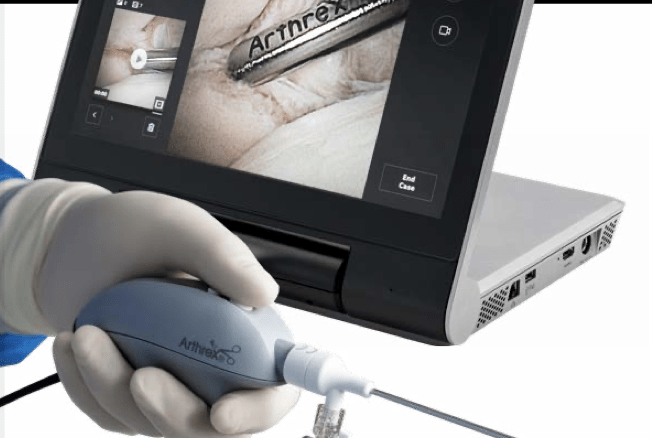Arthroscopy
Arthroscopy is a surgical procedure that orthopaedic surgeons use to visualize and treat problems inside a joint.
The word arthroscopy comes from two Greek words, “arthro” (joint) and “skopein” (to look). The term literally means “to look within the joint.”
In arthroscopic surgery, an orthopaedic surgeon makes a small incision in the patient’s skin, then inserts pencil-sized instruments that contain a small lens and lighting system to magnify and illuminate the structures inside the joint. Light is transmitted through fiber optics to the end of the arthroscope that is inserted into the joint.
By attaching the arthroscope to a miniature camera, the surgeon is able to see the interior of the joint through this very small incision, rather than the larger incision needed for open surgery.
An arthroscope is a small, thin tube that is inserted into the body. A camera and light source are attached to the arthroscope.
The camera attached to the arthroscope displays the image of the joint on a video monitor, allowing the surgeon to look, for example, throughout the knee. This lets the surgeon see the cartilage, ligaments, and under the kneecap. The surgeon can determine the amount or type of injury and then repair or correct the problem, if it is necessary.
When is arthroscopy used?
Your bones, cartilage, ligaments, muscles, and tendons can all be damaged by disease and injury. To diagnose your condition, your surgeon will take a thorough medical history, perform a physical examination and order imaging studies — usually x-rays. For some conditions, an additional imaging study — such as a magnetic resonance imaging (MRI) scan or a computerized tomography (CT) scan — may also be needed. After making a diagnosis, your doctor will determine the most appropriate treatment choice for your condition.
Conditions
Conditions that are commonly treated with arthroscopic procedures include:
• Inflammation. For example, synovitis is a condition that causes the tissues surrounding the knee, shoulder, elbow, wrist, and ankle joint to become inflamed.
• Acute or chronic injuries, including:
◦ Rotator cuff tendon tears
◦ Shoulder impingement
◦ Recurrent dislocation in the shoulder
◦ Meniscal (cartilage) tears in the knee
◦ Chondromalacia (wearing or injury of the cartilage cushion in the knee)
◦ Anterior cruciate ligament (ACL) tears with instability in the knee
◦ Carpal tunnel syndrome in the wrist
◦ Loose bodies of bone and/or cartilage, particularly in the knee, shoulder, elbow, ankle, or wrist
Some problems associated with arthritis can also be treated arthroscopically.
Procedures
The procedures below are performed either with arthroscopy or with a combination of arthroscopic and open surgery:
• Rotator cuff repair
• Repair or resection of torn cartilage (meniscus) from the knee or shoulder
• Reconstruction of the anterior cruciate ligament (ACL) in the knee
• Removal of the synovium in the knee, shoulder, elbow, wrist, or ankle
• Release of the carpal tunnel in the wrist
• Repair of torn ligaments
• Removal of loose bone or cartilage in the knee, shoulder, elbow, wrist, or ankle
Although the inside of nearly all joints can be viewed with an arthroscope, six joints are most frequently examined with this instrument. These are the knee, shoulder, elbow, ankle, hip and wrist. As advances are made in fiberoptic technology and new techniques are developed by orthopaedic surgeons, other joints may be treated more frequently in the future.
What are the possible complications?
Although uncommon, complications do occur occasionally during or after arthroscopy. Infection, blood clots of a vein (also called deep vein thrombosis or DVT), excessive swelling or bleeding, damage to blood vessels or nerves, and instrument breakage are the most common complications; however, these occur in far less than 1 percent of all arthroscopic procedures.
What are the advantages?
Although arthroscopic surgery has received a lot of public attention because it is often used to treat well-known athletes, it is an extremely valuable tool for all orthopaedic patients and is generally easier on the patient than open surgery. Most patients have their arthroscopic surgery as outpatients and are home several hours after the surgery.
What is recovery like after arthroscopy?
The small puncture wounds take several days to heal. The operative dressing can usually be removed the morning after surgery, and adhesive strips can be applied to cover the small healing incisions.
Although the puncture wounds are small and pain in the joint that underwent arthroscopy is minimal, it takes several weeks for the joint to maximally recover. A specific activity and rehabilitation program may be suggested to speed your recovery and protect future joint function.
It is not unusual for patients to go back to work or school or resume daily activities within a few days. Athletes and others who are in good physical condition may, in some cases, return to athletic activities within a few weeks. Remember, though, that people who have arthroscopy can have many different diagnoses and preexisting conditions, so each patient’s arthroscopic surgery is unique to that person. Recovery time will reflect that individuality.


